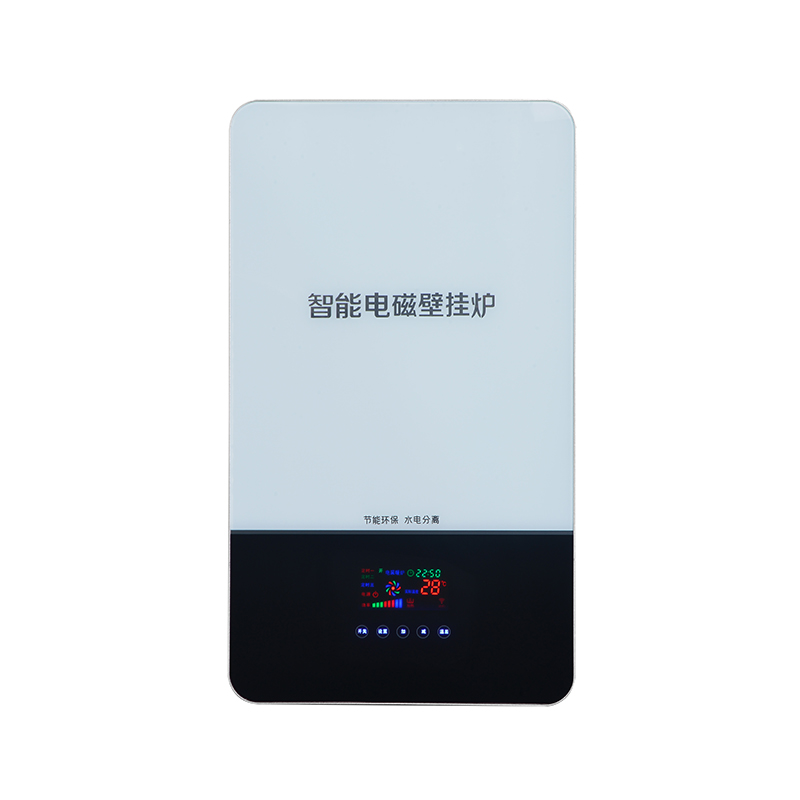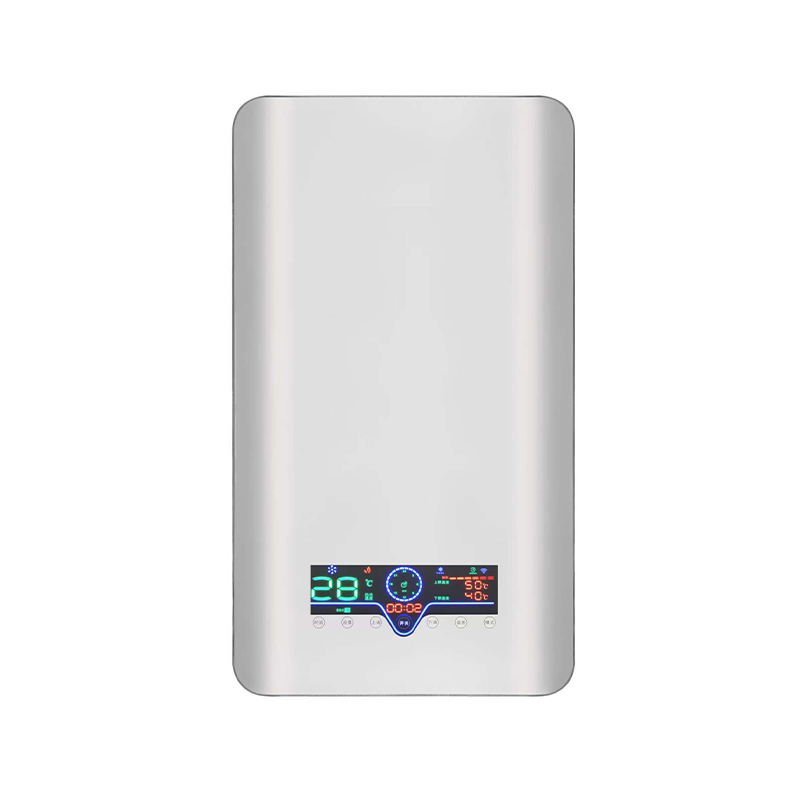How does the curved design affect the heating efficiency of an electromagnetic heating furnace?
Release Time : 2025-08-13
The curved design significantly impacts the heating efficiency of an electromagnetic heating furnace. This unique shape isn't simply aesthetically pleasing or innovative; it's the result of optimization based on scientific principles and user experience. First, from a physical perspective, the curved design changes the way heat is distributed in traditional flat induction cooktops, allowing heat to more evenly cover the pot bottom, thereby improving overall heating efficiency.
In traditional flat induction cooktops, the flat heating area can create a slight gap between the pot bottom and the heating surface, reducing heat transfer efficiency. The curved design, however, naturally curves to fit the shape of most standard pot bottoms, eliminating unnecessary space and ensuring more direct and efficient heat transfer. This means that when a pot is placed on a curved electromagnetic heating furnace, nearly the entire pot bottom is in close contact with the heating surface, maximizing the heat generated by electromagnetic induction and avoiding energy waste.
Furthermore, the curved design helps create a more optimal magnetic field distribution. Electromagnetic heating relies on an alternating magnetic field to generate eddy currents at the pot bottom. The curved structure optimizes the direction and strength of the magnetic field, ensuring a more concentrated magnetic field at the bottom of the pot, improving energy conversion efficiency. Compared to flat designs, the curved design better accommodates pots of varying sizes and shapes, achieving optimal heating results for both round and square pots. This undoubtedly enhances the device's versatility and practicality.
Furthermore, the curved electromagnetic heating furnace offers unique advantages in improving the user experience. For users, the curved edges not only enhance visual appeal but also enhance operating comfort. For example, when moving the pot, the curved corners are less likely to scratch the table or other utensils, reducing the risk of injury from accidental collisions. More importantly, this design makes it easier to monitor the food inside the pot, as the view isn't obstructed by an overly protruding edge. This is particularly important for those who frequently monitor cooking progress.
From an energy efficiency perspective, the curved design helps reduce energy loss. Due to its optimized magnetic field distribution and enhanced heat transfer efficiency, curved electromagnetic heating furnaces typically reach the set temperature faster than traditional designs for the same power output and consume less energy to maintain a constant temperature. This feature not only conserves electricity but also contributes to environmental protection. While specific values vary by brand and model, the overall trend shows that the curved design can indeed reduce energy consumption while maintaining or even improving heating speed.
In addition to the aforementioned advantages, curved electromagnetic heating furnaces also offer certain advantages in terms of durability. Their unique design allows for a more compact layout of internal components, which helps the heat dissipation system function more effectively and prevents overheating. This excellent heat dissipation extends the lifespan of electronic components and reduces failure rates caused by high temperatures. Furthermore, considering the cleaning and maintenance needs of daily use, the curved surface is easier to wipe clean than sharp-edged designs, reducing the likelihood of oil residue and keeping the device looking like new for a long time.
It is worth noting that while the curved design offers many benefits, it also presents some challenges. For example, it requires more complex manufacturing processes, which may increase costs accordingly. Furthermore, it may not fully achieve optimal heating performance with certain pot shapes. However, with technological advances and accumulated production experience, these issues are gradually being addressed.
In short, the curved design brings numerous improvements to electromagnetic heating furnaces, particularly in heating efficiency, user experience, and energy efficiency. It not only enhances the convenience and safety of cooking but also contributes positively to energy conservation and emission reduction. Through its meticulously designed curved structure, the electromagnetic heating furnace achieves a comprehensive upgrade from its appearance to its inherent performance, making it an indispensable and ideal choice for modern kitchens. In the future, we believe that with the incorporation of more innovative elements, these products will become even more intelligent, efficient, and user-friendly.
In traditional flat induction cooktops, the flat heating area can create a slight gap between the pot bottom and the heating surface, reducing heat transfer efficiency. The curved design, however, naturally curves to fit the shape of most standard pot bottoms, eliminating unnecessary space and ensuring more direct and efficient heat transfer. This means that when a pot is placed on a curved electromagnetic heating furnace, nearly the entire pot bottom is in close contact with the heating surface, maximizing the heat generated by electromagnetic induction and avoiding energy waste.
Furthermore, the curved design helps create a more optimal magnetic field distribution. Electromagnetic heating relies on an alternating magnetic field to generate eddy currents at the pot bottom. The curved structure optimizes the direction and strength of the magnetic field, ensuring a more concentrated magnetic field at the bottom of the pot, improving energy conversion efficiency. Compared to flat designs, the curved design better accommodates pots of varying sizes and shapes, achieving optimal heating results for both round and square pots. This undoubtedly enhances the device's versatility and practicality.
Furthermore, the curved electromagnetic heating furnace offers unique advantages in improving the user experience. For users, the curved edges not only enhance visual appeal but also enhance operating comfort. For example, when moving the pot, the curved corners are less likely to scratch the table or other utensils, reducing the risk of injury from accidental collisions. More importantly, this design makes it easier to monitor the food inside the pot, as the view isn't obstructed by an overly protruding edge. This is particularly important for those who frequently monitor cooking progress.
From an energy efficiency perspective, the curved design helps reduce energy loss. Due to its optimized magnetic field distribution and enhanced heat transfer efficiency, curved electromagnetic heating furnaces typically reach the set temperature faster than traditional designs for the same power output and consume less energy to maintain a constant temperature. This feature not only conserves electricity but also contributes to environmental protection. While specific values vary by brand and model, the overall trend shows that the curved design can indeed reduce energy consumption while maintaining or even improving heating speed.
In addition to the aforementioned advantages, curved electromagnetic heating furnaces also offer certain advantages in terms of durability. Their unique design allows for a more compact layout of internal components, which helps the heat dissipation system function more effectively and prevents overheating. This excellent heat dissipation extends the lifespan of electronic components and reduces failure rates caused by high temperatures. Furthermore, considering the cleaning and maintenance needs of daily use, the curved surface is easier to wipe clean than sharp-edged designs, reducing the likelihood of oil residue and keeping the device looking like new for a long time.
It is worth noting that while the curved design offers many benefits, it also presents some challenges. For example, it requires more complex manufacturing processes, which may increase costs accordingly. Furthermore, it may not fully achieve optimal heating performance with certain pot shapes. However, with technological advances and accumulated production experience, these issues are gradually being addressed.
In short, the curved design brings numerous improvements to electromagnetic heating furnaces, particularly in heating efficiency, user experience, and energy efficiency. It not only enhances the convenience and safety of cooking but also contributes positively to energy conservation and emission reduction. Through its meticulously designed curved structure, the electromagnetic heating furnace achieves a comprehensive upgrade from its appearance to its inherent performance, making it an indispensable and ideal choice for modern kitchens. In the future, we believe that with the incorporation of more innovative elements, these products will become even more intelligent, efficient, and user-friendly.





